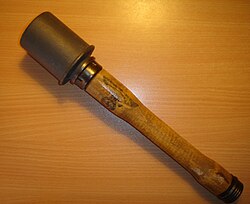Model 24 grenade
| Model 24 Stielhandgranate | |
|---|---|

German stick grenade Model 24
|
|
| Type | Hand grenade |
| Place of origin |
|
| Service history | |
| In service | 1915–1945 |
| Production history | |
| Designed | 1915 |
| Specifications | |
| Weight | 595g |
| Length | 365 mm |
| Diameter | 70 mm |
|
|
|
| Filling | Trinitrotoluene |
|
Detonation
mechanism |
4 1/2 seconds |
The Model 24 Stielhandgranate (German, "stalk hand grenade") was the standard hand grenade of the German Army from World War I until the end of World War II. The very distinctive appearance led to it being called a "stick grenade", or a "potato masher" in British Army slang, and is today one of the most easily recognized infantry weapons of the 20th century.
The stick grenade was introduced in 1915 and the design developed throughout World War I. A friction igniter was used; this method was uncommon in other countries, but widely used for German grenades.
A pull cord ran down the hollow handle from the detonator within the explosive head, terminating in a porcelain ball held in place by a detachable base closing cap. Pulling the cord dragged a roughened steel rod through the igniter causing it to flare up and start the five-second fuse burning.
These exposed pull cords had a tendency to accidentally snag and detonate the grenades while being carried so a threaded cap securing the cord and ball in the base of the grenade handle was added.
Stick grenades were stored in cases for transport, and their fuse assemblies inserted prior to going into combat — a reminder was stenciled on each explosive charge ("Vor Gebrauch Sprengkapsel einsetzen" "Before use insert detonator").
With its high-explosive charge encased in a thin sheet steel can, the Model 24 was fundamentally a "concussion grenade" which relied on blast effect, rather than an anti-personnel fragmentation grenade. A serrated fragmentation sleeve ("Splitterring") was adopted in 1942 which could be slid over the head of the grenade. Fragments of the sleeve would be scattered on detonation, making the grenade more effective against personnel.
The stick provided a lever, significantly improving the throwing distance. The Model 24 could be thrown approximately 27 metres (30 yd) to 37 metres (40 yd), whereas the British Mills bomb could only be thrown about 14 metres (15 yd) (however the British War Office report "WO 291/472 Performance and handling of HE grenades" gives an average figure for a standing throw of a Mills bomb as 27 metres (30 yd), when crouched 23 metres (25 yd) and lying 22 metres (24 yd)). The stick design also reduced the risk of the grenade rolling downhill back towards the thrower when used in hilly terrain or in urban areas. However, the additional length of the handle meant that fewer could be carried.
...
Wikipedia
